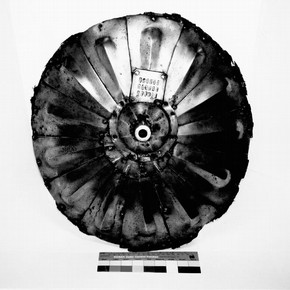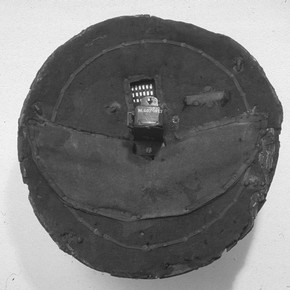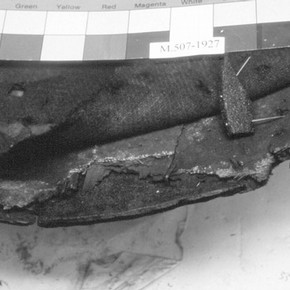Conservation Journal
Autumn 2001 Issue 39
A gun-shield from the armoury of Henry VIII: Decorative oddity or important discovery?

Figure 1. The front during treatment. 46cm wide 48cm. Museum no 507-1927. Photography by S Metcalf (click image for larger version)
This is a preliminary report on the technical investigation and conservation of a 16th century gun-shield, now at the V&A, which was treated for the British Galleries project. The work is an example of the value of collaborative research across disciplines. It illustrates the importance for the conservator of understanding the object to be treated and how, by taking a collaborative approach, new historical information and conservation methods can be found.
The V&A’s gun-shield is from a group of some 46 surviving examples originally from the armoury of Henry VIII at the Palace of Westminster, the Tower of London and other Royal sites. Eight gun-shields have also been found on the wreck of the Mary Rose. The gun-shields are listed in the inventory of 1547 taken after Henry VIII’s death as 'targettes steiled wt gonnes xxxv' (targets steeled with guns 35)1 .
They have been thought to be Italian in origin, as they were offered to Henry VIII in a letter of 1544 from a painter of Ravenna named Giovanbattista2 . They are described as 'several round shields and arm pieces with guns inside them that fire upon the enemy and pierce any armour'. They are an unusual example of a short-lived technological innovation and Henry VIII’s interest in new inventions.
The V&A gun-shield has been on display in the arms and armour gallery for many years. Apart from interest on the part of arms and armour scholars, it had become a decorative oddity largely ignored by the Museum. The selection of the gun-shield for display in the new British Galleries and the subsequent programme of conservation and research has changed this view. It has resulted in new discoveries, which have emphasised the importance of these objects both for the British Galleries project and for historians.
Preliminary investigation and condition
The V&A gun-shield consists of a breech loading matchlock pistol surrounded by a wood shield. The front of the shield (figure1) is armoured with ferrous plates and a central boss through which the gun points. Above the gun there is a metal grill for sighting. The back of the gun-shield (figure 2) is upholstered with a red textile lining, a yellow textile pad for the arm of the user and traces of carrying straps.
Overall the object was in poor condition. The ferrous plates were covered in rust, degraded grease and oil. Areas of wear, dents and minor splits were evident. Under the base of the boss there was an old repair or alteration. The boss and gun were loose and crudely attached with modern nails. The reverse and edges of the shield were covered in dirty and friable textiles. Attached to the upholstery were the remains of leather straps, upholstery tacks and linen tape. Under the pad, stuffing could be seen. Areas of the edge were damaged with losses to the wood carcass, leaving the textile unsupported. Traces of paint were noted on the metal plates and on the textile.
During this first examination many features were unclear. The exact age of the upholstery was unknown. It was uncertain how the gun-shield actually worked or what precisely the paint traces were.
Technical investigation and research
As the gun-shield was so complex it was important to understand the object historically and technically to develop an appropriate conservation treatment. To achieve this it was essential to use expertise across several disciplines. Two approaches were taken. Firstly, expert opinion was invited to examine, and discuss the gun-shield. Secondly, other examples of gun-shields were examined and information collected by the authors. Fifteen gun-shields from the Royal Armouries collection at the Tower of London and seven from the Royal Collection at Windsor Castle were examined. Information on gun-shields in collections abroad was obtained by correspondence. In total the investigation involved eight museums / institutions and eighteen individuals. The research and analysis of all the various elements is on-going, due to the importance of the object in the light of new discoveries.
The key discoveries, which have caused the revaluation of the gun-shields are:
-
There are two distinct types of gun-shield. One of Italian manufacture and one (like the V&A example) an English version of heavier construction. The Italian examples have different features, including lighter calibre barrels offset to the upper half of the shield, gilding and engraved decoration in some cases and a much smaller sighting hole, if any. They are generally of better quality in both construction and ornament.
-
A maker’s mark (as yet unidentified) has been found on some of the barrels.
-
There is evidence to suggest that the English gun-shields were converted from plain targets. At least two unconverted examples have been located; one, significantly, at the Tower of London.
-
The English version is probably for use on ship, rather than hand-held like the lighter Italian version. It could be attached in rows to the ship’s gunwale, for example, to act as a shield and anti-personnel weapon. Some examples have a hole in the matchlock serpentine for the attachment of a lanyard. This may explain why some were found on the Mary Rose.
-
All the upholstery and textiles on the V&A gun-shield (and others) are circa 1540s, most probably of English manufacture, and are extremely rare. This reinforces the argument for this type of gun-shield being English.
-
The red and yellow textiles may be Royal Household livery, as new red and yellow livery was issued to the Royal Household in 1544.
-
Differing styles of textile trimming or metal strip decoration have been noted.
-
Evidence of use, such as gunpowder residue, burns and repairs to the gun-shields, may be observed on some examples.
-
The paint traces on the V&A example are part of an earlier paint scheme still found on other examples examined. Paint analysis has identified Prussian Blue which was not manufactured before 1704, thus giving an earliest date for the painting of the gun-shields.
-
The work has resulted in the discovery of some important examples of English wool cloth for textile historians. It has added to the story of Henry VIII’s innovative approach to acquiring and developing new weapons by classifying the gun-shields into Italian and English types. It has also provided a new English context to an object being displayed in a project telling the story of British art and design.
Conservation treatment
Understanding the technical features, the importance of such elements as the upholstery and the wider significance of the objects in the history of English materials and design were crucial to the conservation treatment. The treatment in turn also fed back into the research, providing new discoveries; for example:
-
The examination and repair of the loose boss and gun supports other evidence that the gun-shields were fired from a fixed position rather than hand held. The damage and old repairs on the V&A gun-shield and others of this type suggest that the fixed shield could not absorb the recoil energy of repeated shots, and that this is why the gun-shields were a short-lived innovation.
-
Knowing that the V&A gun-shield was probably completely painted in the past has led to traces of paint being identified on ferrous parts so the earlier paint scheme has been recorded and conserved.
-
Being aware before treatment that the V&A gun-shield may have had textile trimmings meant that the small fragments of textile tape found under the boss and on the shield edge have been correctly interpreted. These suggest that the iron plates were originally bordered with a particular style of trimming.
-
Knowing the construction of the upholstery edge found on other gun-shields has meant that the loose textiles on the V&A gun-shield edge have been appropriately supported, using a new method. Plastazote inserts were pinned into position between the laths of the wood carcass. The textiles were then attached to the foam with wheat starch adhesive (figure 3).
-
Detecting evidence of use before treatment allowed analysis of the possible gun-powder residues.
Conclusion
This article has outlined some of the discoveries and conservation methods used during the treatment of what was thought to be a oddity in the V&A’s collection. The study of other examples of gun-shields was essential in developing an appropriate conservation treatment for the V&A gun-shield and has avoided the inadvertent loss of important historical information. The collaborative approach across disciplines has proved invaluable. It has ensured that a sympathetic treatment has been undertaken and that the information an object can provide during conservation has been utilised, making a misfit into a valuable addition to the British Galleries.
Acknowledgements.
We are grateful to the many institutions and individuals who have contributed expertise and information to this project.
References
1. Blair, CBT: European Armour, 1958, Batsford, London, pp182-183
2. Archaeologia., Vol LI, p246
Autumn 2001 Issue 39
- Editorial
- A concise approach: Managing information for the British Galleries Conservation Programme
- Reverse painting on glass in the British Galleries
- Book display in the British Galleries
- Too big for his boots - Relocation of the Wellington Monument model
- Overview of the gilded objects treated for the British Galleries
- East meets West: The Althorp Triad
- A gun-shield from the armoury of Henry VIII: Decorative oddity or important discovery?
- Conservation or restoration? Treatment of an 18th century clock
- The British Galleries project from a paintings conservation perspective
- Chinese wallpapers in the British Galleries
- Censer: Making Sense of an Object
- Ephemeral or permanent? Illuminating the Bullerswood carpet
- Conservation of a crewelwork bed curtain
- Printer friendly version

